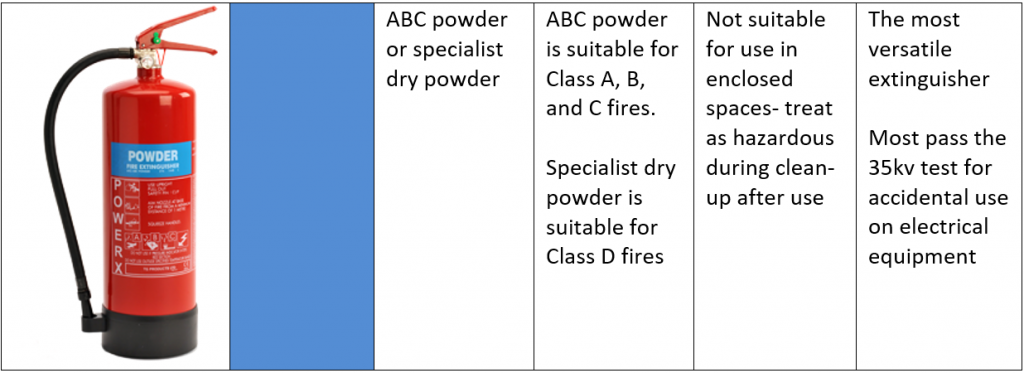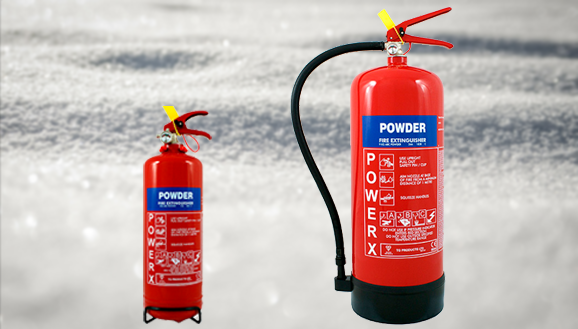Chapter 3 – The Dry Powder Fire Extinguisher.
In this third chapter of our comprehensive guide to fire extinguishers we will be examining a type of fire extinguisher known as the dry powder fire extinguisher. Occasionally referred to as a dry chemical extinguisher, there have been many variants of this extinguisher over the years, such as the BC powder extinguisher which used bicarbonate of soda to extinguish the flames.
The Overview:

The Details:
Dry powder extinguishers come in two distinct commercially available varieties- the ABC powder extinguisher invented in Europe in the 1950’s, and the specialist dry powder extinguisher which has been in use since World War Two. They are recognizable by the blue panel above the operating instructions.
ABC powder extinguishers are so named because they are effective on three of the classes of fire- A, B and C. Class A fires are fires involving solid combustibles, like soft furnishings, wood and paper. Class B fires are fires involving flammable liquid fuel, such as oil, petrol, paint and paraffin, and Class C fires are fires involving flammable gases like propane or butane. Many ABC powder extinguishers have been tested against 35kv, which makes them safe if accidentally used on an electrical fire.
A Specialist Dry Powder fire extinguisher is designed specifically for Class D fires, which are fires arising from flammable metals, such as magnesium. These kinds of fires are rare, but can be hot, fast moving, and behave differently to an ordinary fire. They are usually encountered in an industrial setting, and a Class D extinguisher will be flagged immediately by your risk assessor if you work with such substances.
Is A Dry Powder Fire Extinguisher Right For You?
ABC dry powder extinguishers are excellent all-round extinguishers best suited for outdoor use. Garages, forecourts, and camping grounds- particularly anywhere that there is a risk of a Class C fire are good places for an ABC extinguisher. ABC extinguishers should not be used in enclosed spaces or indoors without a specific risk assessment because the powder poses a health hazard if inhaled, and can obstruct visibility in the event of an evacuation. Any vehicle which is considered to carry dangerous goods is required to be fitted with one or more ABC dry powder extinguishers with the specific amount determined by the weight of the vehicle.
Specialist dry powder extinguishers are most commonly found in laboratories or in buildings used for industrial processes.
Call our friendly advisors on 01785 252568 and let us find the right dry powder extinguisher for you.
How do dry powder fire extinguishers work?
ABC dry powder extinguishers work in a very unique way. A fire can only exist in the presence of all four elements of the fire tetrahedron- heat, fuel, oxygen and a chemical reaction. Each extinguisher works by removing one or more parts of the tetrahedron. In the case of an ABC dry powder extinguisher the powder interferes with the chemical reaction taking place between the fuel and the oxygen in order to put out the fire. A specialist dry powder extinguisher works by forming a thick solid crust over the burning metal, preventing oxygen from coming into contact with the fuel.
How Should I Store and Maintain A Dry Powder Fire Extinguisher?
Any fire extinguisher should be properly commissioned and installed by a BAFE certified engineer, after a thorough fire risk assessment has been carried out on your property. ABC dry powder fire extinguishers are usually sited 30m from a Class A or C fire risk, or 10m from a Class B risk. Specialist dry powder fire extinguishers should be situated based on the recommendations from a fire risk assessment. You should perform a visual inspection on your fire extinguishers at least once a month, checking for any visible signs of damage, such as dents or loss of pressure. A full safety inspection should be carried out by a qualified inspector every 12 months after installation, and a complete discharge and refill should be carried out after five years. Chase Fire are proud of our range of products and their durability, and as a result we offer a full 5-year guarantee on all our fire extinguishers.
How Do I Use A Dry Powder Fire Extinguisher?
| P | Pull the pin from the side of the handle |
| A | Aim the hose at the base of the flames, standing about two metres away for Class A fires. For Class B fires aim at the nearest edge of either the container of a contained flammable liquid, or the nearest edge of a free-flowing liquid hazard. For Class C fires where possible you should make sure the gas supply to the fire is switched off before attempting to fight the fire. For Class D fires using a specialist dry powder extinguisher follow the protocol for your specific industrial hazard. |
| S | Squeeze the handle to release the ABC powder in a steady flow. Be careful not to breathe any in. |
| S | Sweep the hose from side to side so that the powder covers the entirety of the burning area when dealing with a Class A fire. When attempting to put out a Class B fire, be careful not to push any uncontained liquid fires in case they make contact with other flammable items. For a Class C fire sweep the hose across the fire as you would for a Class A fire once the gas supply has been shut off until the remainder of the fire is out. For Class D fires make sure the entirety of the flaming area is covered in a thick layer of the specialist dry powder. |
IMPORTANT:
- Never turn your back on a fire
- Always have an escape route planned
- Call the fire and rescue services if you encounter any difficulties
- Leave the building if you fail to put out the fire or if it re-ignites at any point

